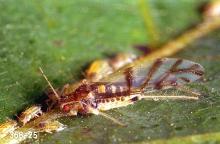Includes
Dusky-veined aphid (Panaphis juglandis)
Walnut aphid (Chromaphis juglandicola)
Pest description and crop damage Walnut aphids are pale yellow, much smaller than the dusky-veined aphid, and feed on the lower surface of leaves. Dusky-veined aphids have dark banded spots on their backs and are found feeding along the mid-vein on the top surface of leaves. Both aphids suck plant juice and deposit honeydew. Feeding of the dusky-veined aphid causes the leaf midrib to turn black. The honeydew is toxic to the husk of some varieties and sooty mold growing on the honeydew turns the husk black. High populations may lead to leaf drop and a loss of nut yield and quality. Aphid populations are most damaging in spring and early summer when nuts are developing rapidly.
Pest monitoring Begin observing shoots prior to budbreak, as management is best undertaken early while the aphids are small.
Management-biological control
In the 1980s, a parasitic wasp (Trioxys pallidus) was introduced, which has reduced problems with the walnut aphid substantially. In addition, aphids have many natural enemies including ladybeetles, big-eyed bugs (Geocoris spp.), mirid bugs (Deraeocoris spp.), syrphid fly larvae, and green lacewings. Avoid broad-spectrum insecticide applications when predators and parasitoids are active against aphids.
Management-cultural control
Aphid populations tend to be higher in plants that are fertilized liberally with nitrogen.
Home orchardists: Avoid excessive watering which, together with nitrogen applications, produces flushes of succulent growth. Control ants, which "farm" the aphids for their honeydew and protect them from predators.
Management-chemical control: HOME USE
Dormant-season spray
Apply only during dormant or delayed-dormant period. Use enough water to cover tree thoroughly including small limbs and shoots.
- dormant oil
Growing-season spray
Predators usually reduce aphid populations. Apply pesticides only when predators are few and aphid population is heavy and increasing.
- azadirachtin (neem oil)-Some formulations are OMRI-listed for organic use.
- Beauveria bassiana ATCC 74040 (Naturalis L)
- bifenthrin-Highly toxic to bees. Do not apply when bees are actively foraging; wait until after trees have flowered.
- carbaryl-Highly toxic to bees. Do not apply when bees are actively foraging; wait until after trees have flowered.
- esfenvalerate-Highly toxic to bees. Do not apply when bees are actively foraging; wait until after trees have flowered.
- horticultural oil-Some formulations OMRI-listed for organic use.
- imidacloprid-Highly toxic to bees. Do not apply when bees are actively foraging; wait until after trees have flowered. Do not make more than one application a year. PHI 7 days.
- insecticidal soap-May require several applications to be effective. Some formulations are OMRI-listed for organic use.
- permethrin-Highly toxic to bees. Do not apply when bees are actively foraging; wait until after trees have flowered.
- plant-derived essential oils (clove, garlic, peppermint, rosemary oil, canola, etc.)-Some formulations are OMRI-listed for organic use and have shown efficacy against aphids.
- potassium laurate (often as mix with other ingredients)
- pyrethrins (often as a mix with other ingredients)-Highly toxic to bees. Do not apply when bees are actively foraging; wait until after trees have flowered. Some formulations are OMRI-listed for organic use.
- zeta-cypermethrin-Highly toxic to bees. Do not apply when bees are actively foraging; wait until after trees have flowered.
Management-chemical control: COMMERCIAL USE
Aphids seldom warrant control. Predators usually reduce aphid populations. Pesticide applications are advised only when predators are few and aphid population is heavy.
- acetamiprid (Assail 30SG) at 0.047 to 0.18 lb ai/A. No more than 4 applications and a maximum of 0.72 lb ai/A per growing season. Retreatment interval 14 days. PHI 14 days.
- alpha-cypermethrin (Fastac EC) at 0.02 to 0.025 lb ai/A. Retreatment interval 7 days. Maximum 0.075 lb ai/A. PHI 7 days.
- azadiracthtin (Azasol, Azatin, others)-See label for rates. Some formulations are OMRI-listed for organic use. REI 4 hr.
- Beauvaria bassiana (Mycotrol ESO)-See label for rates. OMRI-listed for organic use.
- beta-cyfluthrin (Baythroid XL) at 0.19 to 0.022 lb ai/A. Maximum per 14 day and per season: 0.022 lb ai/A. PHI 14 days.
- bifenthrin (Brigade WSB) at 0.05 to 0.2 lb ai/A. PHI 7 days. REI 12 hr.
- bifenthrin/Abamectin B1 (Athena) at 7.5 to 20 fl oz/A. Retreatment interval 21 days. Maximum of two applications per season. PHI 21 days.
- clothianidin (Belay) at 0.05 to 0.1 lb ai/A. Maximum 0.2 lb ai/A. PHI 21 days.
- cyantraniliprole (Exirel) at 13.5 to 20.5 oz. Retreatment interval 7 days. PHI 5 days. REI 12 hr.
- deltamethrin (Delta Gold) at 0.02 to 0.033 lb ai/A. Maximum 0.165 lb ai/A. Retreatment interval 7 days. PHI 21 days.
- esfenvalerate (Asana XL) at 0.05 to 0.1 lb ai/A. PHI 21 days. REI 12 hr. Do not exceed 0.2 lb ai/A per season. Do not feed or graze livestock on treated orchard floors. Extremely toxic to fish and aquatic habitat.
- horticultural oil-Some formulations OMRI-listed for organic use.
- imidacloprid (Admire Pro) at 7 to 14 oz for soil application or 1.2 to 2.4 oz for foliar application. PHI 7 days. REI 12 hr. Generic formulations of imidacloprid are available.
- insecticidal soap (M-Pede) at 2% solution. PHI 0 days. Some formulations are OMRI-listed for organic use.
- lambda-cyhalothrin (Warrior II) at 0.02 to 0.04 lb ai/A. PHI 14 days. REI 1 day. Do not exceed 0.16 lb ai/A per season or 0.12 lb ai post bloom.
- malathion (Malathion 57% EC and others) at 0.2 to 0.4 oz/A or up to 2.5 lb ai/A. PHI 7 days. REI 24 hr.
- pyriproxyfen (Esteem 35WP) at 4 to 5 oz /A. PHI 21 days. REI 12 hr. Do not exceed two applications per season.
- spirotetramat (Movento) at 6 to 9 fl oz. PHI 7 days.
- sulfoxaflor (Transform WG) at 0.75 to 1.5 oz. PHI 7 days. REI 12 hr.
- tolfenpyrad (Bexar) at 17 to 27 oz. PHI 14 days. REI 12 hr.
- zeta-cypermethrin (Mustang, Mustang Max, Mustang Maxx) at 0.02 to 0.025 lb ai/A. Maximum of 0.125 lb ai/A per seaon. PHI 21 days.






